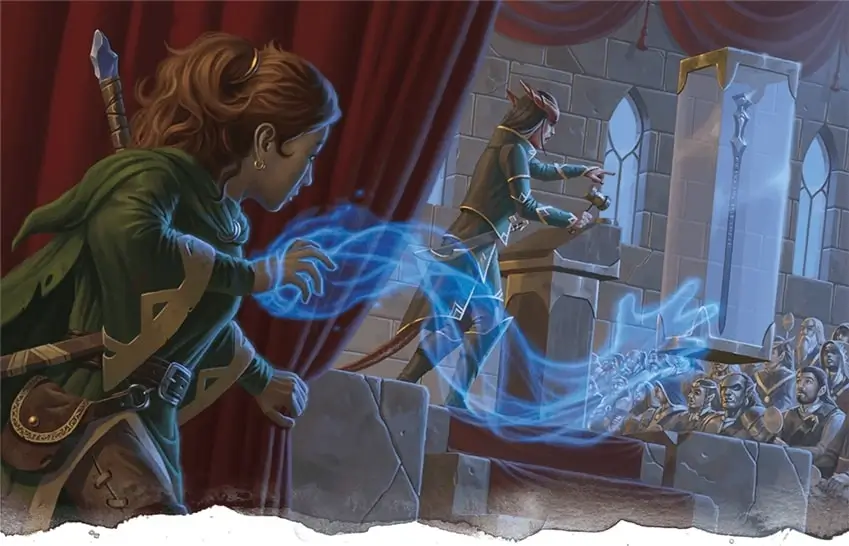You’ve created a brand new character, and now it’s time to select the cantrips you’ll be taking.
If one of your cantrips could be a traumatic experience at the very least, one of your trips should be able to serve a purpose.
Mage Hand provides amazing utility and out-of-the-box solutions to every problem the Dungeon Master throws at you.
This is an overview of one of the most effective cantrips for utility in D&D 5e.
A floating, spectral hand is displayed at a location that you decide to place within the limits. The hand is visible for the duration and will remain until the time you remove it as an act.
The hand disappears if it exceeds 30 feet from you or when you attempt to cast the spell again.
You can make use of your actions to control your hand. The hand can be used to move an object, unlock a locked door or container, store or take an item out of an unlocked container and pour contents from the vial.
Hands can be moved as far as 30 feet every time you make use of it.
The hand cannot attack the hand, use magic items or carry more than 10 lbs.
Mage Hand Spell Details
School: Conjuration
Level: Cantrip
Casting Time: One Action
Distance: 30 feet
Components: Verbal, Somatic
Duration: One Minute
Mage Hand is a spell that the Mage Hand spell creates a spectral hand in the vicinity of.
It can handle up to ten pounds, and you can make use of new actions to move the hand or make it engage with other objects.
Mage Hand is the third hand, acting wherever you want to be but aren’t.
If you are prepared and plan it properly it is possible to be utilized for nearly any scenario. Influencing a social setting by poking holes into puzzles, utilizing creative tactics to combat as well as specific methods to assist in exploring.
A well-prepared player can use the Mage Hand in all situations.
Is Mage Hand a Good Spell?

Mage Hand is a great spell, and almost everyone who can take it should do so. For a creative player, there are almost endless ways to use it.
Need to carefully check an item of magic that might be cursed?
Try out your Mage Hand.
Worried that you might set off a small explosive?
Try out your Mage Hand.
Want to irritate your friend and draw their attention away from a friendly competition?
Mage Hand will take care of you.
Mage Hand is a very useful utility spell that might even come in handy (pardon the pun) in situations not covered by the rules.
For example, it says that you can use it to open an unlocked door, so your DM may let you use it to check and open windows if you want to sneak into or out of a building.
Just keep in mind that because the spell has both verbal and physical parts, people can see you cast it, and your Mage Hand is visible to anyone who is paying attention, so you probably won’t be very sneaky.
Mage Hand is useful in general, but there is also a feat called Telekinetic that makes your Mage Hand spell even stronger.
With the feat, the Mage Hand can move 60 feet around you without being seen (plus some other nifty features).
Who Gets Mage Hand?
The cantrip appears on the Bard, Artificer Sorcerer Warlock as well as Wizard the spell list.
There is an Arcane Trickster subclass of the Rogue that is always able to get it, as do two other cantrips in the Wizard list.
Mage Hand: Social Uses
Our spell has a limited amount of force it can use, which prevents its combat-related uses directly.
However, that small amount of force may be used for social goals.
If you’re under surveillance or you’re unable to over a certain level, however, you might still make a joke to draw their attention.
To achieve the opposite effect, you could also utilize the Mage Hand to distract someone when you try to sneak by them.
Puzzle Breaking Uses
The most frequent use of mage hand usually is to defy or help solve puzzles and traps the DM develops.
A common feature in puzzles is a piece not being accessible, or even partially out of the reach for the players.
If you’re able to go 30 feet further it is possible to overcome these restrictions.
When there’s a risk of pulling a lever or pressing a button, you may be able to avoid the danger by activating it from the distance.
If a trap is equipped with darkness as an element because the DM is aware that your party does not have Darkvision The torch weighs one pound.
It is therefore easy to transport it to the light in the way you want to.
Creative Combat Uses
In our social segment, The Mage Hand is designed to stop targeted attacks on the subject or the use of magic objects.
We can make use of everyday items to use in indirect combat.
The majority of DMs are against throwing alchemist’s flame, or caltrops on an opponent because they are all clear threats.
However, throwing the alchemist’s fire or caltrops may serve as a barrier to stop the movement.
The adversary would need to be careful or risk losing their speed.
If they have to make a sacrifice in the speed of movement with the use of caltrops to escape or move elsewhere, they will easily be tracked down by your group members.
In certain circumstances, it is possible to subtly prepare to kill your target without engaging in combat.
For instance, the spell permits you to do things like open a bottle. You can add poison to the cup of a target. This is the kind of indirect attack permitted to be used by the Mage Hand.
Mage Hand: The Down Sides
Although there are some very specific uses of its spells, it comes with inherent limitations that prevent it from doing completely everything.
In the first place, Mage Hand cannot be utilized to fight. This makes it ineligible to be employed in long-range melee build.
If it wasn’t for this the user can make the weapon attack from thirty meters away. Or a sorcerer could be sixty feet away and reduce the armor built into and health risk of arcane casters, which would stop them from getting too close to their targets.
Then, Mage Hand isn’t able to be used as a magical item.
The rules for the fifth edition were already created under the assumption that magical items will be difficult to come by.
Additionally, a DM not allowing enough magic items could quickly undermine an entire campaign.
Avoiding a cantrip by using magical items is another way to protect against the dangers of magical items.
The spell prevents the caste from using more than 10 kilograms of force.
This is intended to stop things like lifting or shoving extremely heavy objects that could make the spell difficult to think about to the DM.
With this particular law, it is possible to avoid it when you can think up some ideas.
Finally, Mage Hand is restricted to basic interactions.
Example: You can open a door that is locked however, you aren’t able to open a door.
This restriction is relaxed by acquiring Mage Hand via its Arcane Trickster subclass of the Rogue.
In the role of the Trickster, you could utilize the trickster to take something from an object, place an object on the target or choose the lock.
Fun & Creative Exploits
In a game with a wide-ranging scope like Mage Hand There are certain to always be some things that the developers didn’t think of.
This list isn’t exhaustive.
However, it’s a nice collection of tricks and innovative ways to use the Mage Hand that is technically effective.
Flying Halfling
A Sorcerer, Warlock or Wizard would utilize this third-level spell fly… effectively fly.
What if we were to fly using the Mage Hand?
The only issue has to do with the fact it is that the Mage Hand has a limit on the weight of 10 pounds. Halflings are among the races that make up the core, however, they are still weighing forty pounds.
However, with the second-level reduction spell their weight and size are decreased to one-eighth of their original, making us an eight-pound spellcaster.
By using this Reducing-Mage Hand combination that is available, the Sorcerer or Wizard could fly two levels earlier and utilize the spell slot one level lower.
It should also work for Gnomes Kobolds and some Goblins.
Extended Familiar
By using the ability Locate Familiar it is possible to perform touch spells on your own familiar.
The problem with this is that many common options are characterized by low performance and health.
If you have to get to an individual who is further away, you could allow the familiar to ride on your back to share your first speed of movement.
Utilize your movement to get the familiar another 30 feet. They will then be able to take their own pace before the next turn.
If you can multiclass at least two levels into the Fighter. You can use the Action Surge to apply this urgent touch spell at the start of your turn.
Cloaked Scout
If you’re concerned that there could be enemies lurking in the distance, you can make Your Magie Hand.
Put a cloak over the top of your hand and hold it at least 30 feet ahead of you.
The figure is now cloaked that is ruminating around to catch anyone you’re concerned about.
What if my Mage Hand is invisible?
So this is where you can have a little more fun. Technically, we can’t assume that the line from Mage Hand Legerdemain about people not noticing your spell’s effects also applies to the Telekinetic feat, but it feels like it should and I can’t think of any other way your DM would try to decide it when the answer is right there.
So, even if you’re not an Arcane Trickster, Sleight of Hand makes sense as a way to do Mage Hand things without being seen.
You should probably look into ways to make sure you can pass those checks. You can, for example:
- Choose Wisdom and cast Curse on the target.
- Hex is even better because it doesn’t let the target make a save.
- Choose Dexterity to improve your skills.
- Ask yourself or a friend for help.
- Get help, maybe from a familiar making noise on the other side of the target.
Now that we know as much as we can, let’s go back to some parts of the description. A great way to poison someone’s drink without them noticing is to pour out the contents of a vial with an invisible hand.
Whether that’s “food poisoning on the level of fast food” (thanks, Winglady) or something worse, it’s a big reason why Arcane Tricksters have to learn this cantrip.
Using an invisible hand to put or take something from a desk or bag is a great way to steal something. You can even take things out of their pockets if you are really clever.
Or give them more things to carry. Technically, this is part of the Arcane Trickster class feature, but we’ve already talked about how vague “manipulating an object” is, so the better this will go for you, the higher your persuasion roll against your DM should be.
Someone can be sneakily given anything from incriminating evidence to a live grenade, and if you’re fast enough with the live grenades, you don’t really care about being sneaky as much as running away quickly.
It also lets you do any of the things we’ve talked about so far and make up a story about why you’re doing them. Try to make your target believe they are being haunted so they don’t think you’re behind it.
Almost certainly, Insight will work against that, which makes your earlier Hex or Curse on Wisdom even stronger.
Either an arcane trickster or something with Telekinetic (charisma) is likely to be able to do those rolls well.
Final Words
Mage Hand is a very practical and versatile cantrip.
It is capable of doing numerous of the ideas we have discussed and many other ideas you could come up with in your mind.
If you come up with something that would work but isn’t clear. Allow your DM to determine if they’d be willing to accept the idea.
It’s not a good feeling to make plans for something that’s overruled at the last moment.
In addition to that, you’d like to keep good relations and trust with the Dungeon Master, don’t you?
Best of luck to you all And hope that all your rolls are twenty.









